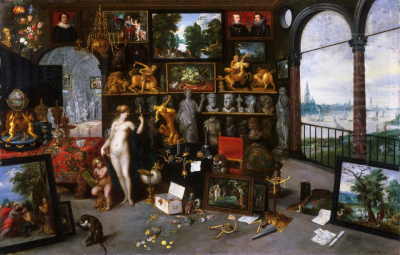
Jan Brueghel the Younger stands as a significant figure in the rich tapestry of Flemish Baroque art. Born into one of the most renowned artistic families in Europe, he inherited not only a name but a thriving workshop and a complex legacy. Active throughout much of the 17th century, his life and career were shaped by the towering reputation of his father, the demands of the art market, and his own considerable talents as a painter of landscapes, allegories, and exquisite still lifes. Navigating the pressures of heritage and competition, he carved out his own identity while ensuring the continuation of the Brueghel artistic tradition.
Early Life and Artistic Formation
Born in Antwerp on September 13, 1601, Jan Brueghel the Younger was destined for a life in art. His father was Jan Brueghel the Elder, himself the son of the legendary Pieter Bruegel the Elder. Jan the Elder, known as "Velvet" Brueghel for his refined technique, was a highly successful and influential painter, celebrated for his detailed landscapes, flower paintings, and allegorical scenes. He ran a large and prosperous workshop in Antwerp, collaborating with leading artists of the day, most notably Peter Paul Rubens.
From a very young age, Jan the Younger was immersed in this artistic environment. His primary training took place within his father's bustling studio, beginning around the age of ten. Here, he learned the meticulous techniques and compositional strategies that characterized the Brueghel style. He absorbed the family's approach to landscape, with its high viewpoints (though he would later often favour lower ones), intricate detail, and vibrant, jewel-like colours. The studio's specialization in various genres, from panoramic vistas to intimate flower studies, provided him with a broad artistic foundation.

To further his education and broaden his horizons, Jan the Younger embarked on a journey to Italy around 1622. This was a common practice for ambitious Northern European artists seeking exposure to classical antiquity and the masterpieces of the Italian Renaissance and Baroque. He spent time in Milan, where he worked for Cardinal Federico Borromeo, one of his father's most important patrons. He also visited Palermo, Sicily, and likely other Italian centres, absorbing the artistic currents of the south. This period abroad was crucial for his development, exposing him to different landscapes, light conditions, and artistic approaches.
Inheritance and the Antwerp Studio
Jan the Younger's Italian sojourn was cut short by tragic news. In 1625, his father, Jan Brueghel the Elder, succumbed to a cholera epidemic in Antwerp. This devastating event forced the young artist, then only 24, to return immediately to his native city. He was now faced with the daunting task of taking over his father's prestigious and extensive workshop, along with its ongoing commissions, inventory, and staff of assistants.
Upon his return, Jan swiftly established himself within the Antwerp artistic community. He joined the city's Guild of Saint Luke, the professional organization for painters and craftsmen, in 1625. His standing grew rapidly, reflecting both his inherited status and his own abilities, and he served as the dean of the Guild for the year 1630-1631. Taking the helm of the Brueghel workshop meant not just managing artistic production but also handling the business side – dealing with patrons, suppliers, and art dealers.
The transition was not without its challenges. While the Brueghel name carried immense weight, the sudden loss of the workshop's master created uncertainty. Jan the Younger had to prove he could maintain the high standards associated with the family name. Furthermore, as noted in records, the period following his father's death brought financial instability, requiring him to manage the studio's assets carefully, sometimes involving the sale of his father's existing works to maintain operations.
Defining a Style: Landscapes and Allegories
Jan Brueghel the Younger worked extensively in landscape painting, a genre central to his family's fame. He continued the tradition of detailed, often panoramic views, frequently populated with small figures engaged in daily activities, biblical narratives, or mythological scenes. His early landscapes often closely followed his father's models in composition and theme, a necessary step to satisfy market demand and fulfill existing orders.
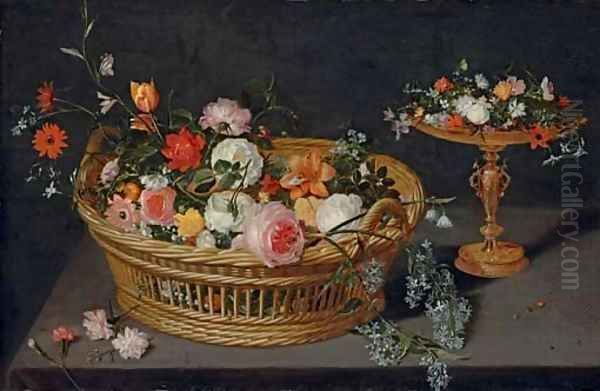
However, as his career progressed, Jan the Younger developed his own stylistic nuances. While maintaining the meticulous detail characteristic of the Brueghels, his brushwork could be somewhat lighter and quicker than his father's. His colour palettes often tended towards cooler tones, and the overall atmosphere in his landscapes can feel softer and less densely packed than those of Jan the Elder. He also frequently employed a lower horizon line in his landscapes, a technique that enhances the sense of depth and immerses the viewer more directly within the scene.
Allegorical landscapes were a significant part of his output. He painted numerous depictions of Paradise, often featuring Adam and Eve surrounded by a harmonious gathering of animals, continuing a theme perfected by his father. These works showcased his skill in rendering diverse fauna and lush vegetation. He also produced series based on themes like the Four Elements (Earth, Air, Fire, Water) or the Four Seasons, often in collaboration with figure painters. Works like The Garden of Eden exemplify his contribution to this genre.
Defining a Style: Flower Painting
Alongside landscapes, Jan Brueghel the Younger excelled in still life painting, particularly flower pieces. His father had been a pioneer in developing the independent flower still life as a genre, and Jan the Younger continued this tradition with great success. He produced numerous paintings depicting bouquets in vases, baskets of flowers, and flower garlands, often rendered with astonishing precision and vibrant colour.
His approach to flower painting built upon his father's legacy but also showed individual traits. He mastered the art of depicting a wide variety of blooms, often combining flowers that bloomed in different seasons into a single, idealized arrangement – a common convention meant to display nature's bounty and the artist's skill. These works, sometimes referred to as "pure flower still lifes," were highly sought after for their decorative beauty and symbolic potential (flowers often carried associations with transience, purity, or divine creation).
Jan the Younger's flower paintings are characterized by their delicate rendering of petals and leaves, careful attention to light and texture, and often, the inclusion of small insects like butterflies or beetles, adding a touch of liveliness and trompe-l'oeil realism. Some analyses suggest his compositions might be slightly less dense or his colours marginally paler than his father's, contributing to a lighter overall effect. His Basket of Flowers is a representative example of his mastery in this domain.
Partnerships in Paint: A Collaborative Spirit
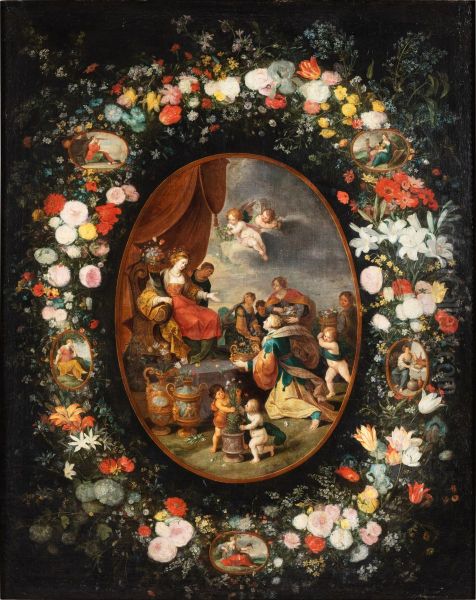
Collaboration was a hallmark of Antwerp painting in the 17th century, and Jan Brueghel the Younger actively participated in this practice, just as his father had. His specialized skills in landscape and still life made him a valuable partner for artists who excelled in figure painting. These collaborations resulted in composite works where each artist contributed their area of expertise, creating rich and complex paintings.
His most famous collaborator, inherited from his father, was Peter Paul Rubens. While their joint efforts may not have been as frequent or perhaps as groundbreaking as the partnership between Rubens and Jan the Elder, they did continue to work together on occasion. Series like The Five Senses, where Rubens typically painted the central figures and Brueghel the surrounding symbolic objects and settings, were continued or replicated in the workshop. However, the exact nature and extent of their collaboration remain subjects of scholarly discussion, with some suggesting Jan the Younger sometimes emulated Rubens' style in collaborative contexts.
Jan the Younger maintained a particularly close and frequent working relationship with Hendrick van Balen the Elder. Together, they produced numerous mythological and allegorical scenes, such as versions of The Four Elements or depictions of nymphs and goddesses in lush landscapes. In these works, Van Balen typically painted the figures, while Brueghel provided the detailed natural settings. This partnership highlights the mutual stylistic influence and efficient division of labour common in Antwerp studios.
He also collaborated with the landscape painter Joos de Momper the Younger. While Momper created expansive, often mountainous vistas, Brueghel would sometimes add the small figures (staffage) or specific details that brought these scenes to life. This relationship demonstrates the interconnectedness of Antwerp artists and their willingness to combine talents.
Further collaborations involved his brother-in-law, David Teniers the Younger (who married Jan's sister Anna Brueghel), a renowned genre painter. They occasionally worked together, likely on details within larger compositions. He also worked with figure painters like Frans Francken the Younger and Abraham Janssens, whose daughter he would marry. Other artists associated with his circle or potential collaborators include Sebastian Vrancx and Gonzales Coques. These partnerships were essential to the workshop's output and reflect the collaborative spirit of the Antwerp school.
The Weight of a Name: Legacy and the Market

Being the son of Jan Brueghel the Elder and grandson of Pieter Bruegel the Elder was both a blessing and a burden. The Brueghel name guaranteed recognition and a ready market, but it also created immense pressure and invited constant comparison. Jan the Younger operated within the shadow of his father's towering reputation, and much of his career involved navigating this complex legacy.
A significant aspect of the Brueghel workshop, both under Jan the Elder and Jan the Younger, was the production of replicas and variants of successful compositions. Jan the Younger completed works left unfinished at his father's death and continued to produce versions of his father's most popular paintings, including landscapes, Paradise scenes, and flower pieces. This was standard workshop practice, driven by high market demand for the Brueghel style.
The issue of signatures and attribution is complex. Sources indicate that Jan the Younger sometimes copied his father's work and sold it under his own signature. Other accounts suggest that works might have been sold bearing his father's signature, either as legitimate workshop productions or potentially to command higher prices. This practice, combined with the stylistic similarities between father and son (especially in Jan the Younger's early work), makes definitive attribution challenging for art historians even today. It also occasionally led to confusion in the market, with his works sometimes being mistaken for those of his father or even his grandfather, Pieter Bruegel the Elder, or his uncle Pieter Brueghel the Younger (known for copying his own father, Pieter the Elder).
Jan the Younger faced significant market pressures. While demand for his work was often strong, the art market could be volatile. Records indicate periods of financial difficulty, particularly in the 1630s when prices for his paintings reportedly dropped. He engaged in disputes with dealers, such as the documented legal conflict with a certain Vermeersum in 1632 over contractual obligations. These challenges underscore the competitive nature of the 17th-century art world, even for an artist with a famous name. He also had competition from within the family, as his brother Pieter Brueghel III also worked as a painter, often replicating works by their grandfather.
Personal Life and Later Years
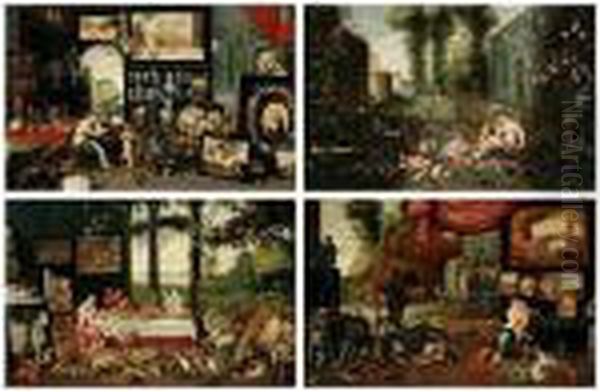
Jan Brueghel the Younger's personal life was marked by family ties within the Antwerp artistic community. In 1626, a year after returning from Italy and taking over the workshop, he married Anna Maria Janssens. She was the daughter of the prominent history painter Abraham Janssens, further cementing his connections within the city's elite artistic circles. This marriage appears to have provided a period of domestic stability.
Tragedy struck again later in his life with the death of Anna Maria. Subsequently, Jan the Younger remarried, taking Maria van Tielt as his second wife. Across his marriages, he fathered a large family, with several of his children continuing the artistic dynasty. Most notable among his sons was Abraham Brueghel, who became a successful still life painter, primarily active in Italy, blending Flemish precision with Baroque dynamism. Other sons like Jan Pieter Brueghel, Ambrosius Brueghel II, and Jan Baptist Brueghel also pursued artistic careers, ensuring the Brueghel name persisted in the art world.
Jan Brueghel the Younger remained active as a painter and head of the workshop for decades. He continued to produce landscapes, still lifes, and allegorical works, adapting his style subtly over time while largely remaining true to the Brueghelian aesthetic. He managed the workshop's production, trained apprentices, and maintained his position within the Antwerp art scene until his later years.
He died in Antwerp on September 1, 1678, just shy of his 77th birthday. He left behind a substantial body of work and a workshop that had successfully transitioned under his leadership, continuing the family's artistic legacy for another generation.
Enduring Influence
Jan Brueghel the Younger occupies a crucial, if sometimes overlooked, position in Flemish art history. While perhaps not possessing the revolutionary genius of his grandfather or the sheer innovative breadth of his father, he was a highly accomplished and prolific painter in his own right. He skillfully inherited and managed one of the most important artistic enterprises in Antwerp, ensuring the continuity of the Brueghel style and brand.
His primary contribution lies in his adaptation and perpetuation of the detailed, brilliantly coloured style associated with his father, particularly in the genres of landscape and flower painting. He successfully navigated the demands of the market, producing works that appealed to the tastes of collectors across Europe. His collaborations with major figures like Rubens and Van Balen underscore his importance within the Antwerp school's network of specialized masters.
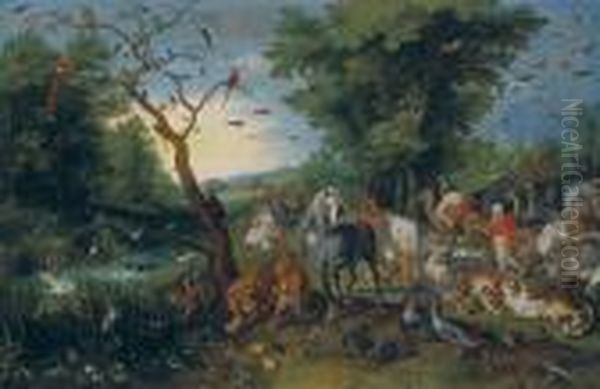
Though sometimes overshadowed by his famous relatives and facing the complexities of attribution that surround the Brueghel dynasty, Jan Brueghel the Younger was a significant artist who sustained a high level of quality and productivity throughout a long career. He served as a vital link in the chain of the Brueghel legacy, transmitting the family's artistic traditions while adding his own distinct, albeit subtle, variations to the Flemish Baroque. His works remain admired for their technical finesse, intricate detail, and enduring charm.